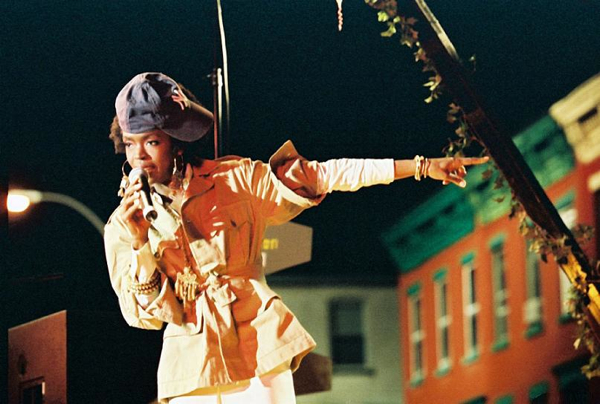Movie review by Greg Carlson
Neither as exuberant as one might hope nor as fulfilling as it needs to be, “Dave Chappelle’s Block Party” nevertheless blows into theaters as a breath of fresh springtime air. A music and comedy-based homage to Mel Stuart’s “Wattstax,” “Block Party” features a tantalizing lineup of hip-hop artists, including Kanye West, Mos Def, Talib Kweli, Common, Erykah Badu, Jill Scott, Dead Prez, the Roots, and the reunited Fugees, among others. Planned by Chappelle as a free neighborhood get-together in Bedford-Stuyvesant, Brooklyn, Michel Gondry’s documentary constructs a breezy, affable, and mostly lighthearted behind-the-scenes look at the planning and execution of the big event.
Purportedly bankrolled in some measure by Chappelle, the project immediately presents the viewer with the impression that a host like Chappelle can and will make just about anything happen. Kicking off in and around Dayton, Ohio, just a few days prior to the September 2004 concert, “Block Party” follows the comedian around town as he distributes golden tickets to a variety of folks – some thrilled, some gracious, some just plain perplexed. The chaotic spirit that accompanies Chappelle’s spontaneous invitation sets the tone for the film, which mostly fails to follow-up later on the average Ohioans who agreed to take the bus ride to NYC. After the promising set-up, the highlight of which is Chappelle’s recruitment of the ecstatic Central State University Marching Band as performers for the show, “Block Party” spends the remainder of its running time cutting primarily between the concert and Chappelle’s preparations for it.
It’s likely that “Block Party” will work better on DVD than at the cinema, assuming that the musical performances will be presented intact. The theatrical version’s single greatest deficiency is a marked attention-deficit disorder, as many of the finest numbers are interrupted to present some other business. While this tactic will disappoint hip-hop fans, viewers hoping for a big-screen version of Chappelle’s television series will not find that either. Instead, Chappelle’s flavorful musings (as he interacts with regular people and stars) range from the blisteringly funny to the slightly bittersweet.
“Block Party” goes out of its way to remain focused on the fun (even if the inclement weather forces Badu to remove her fantastic Angela Davis afro), but Gondry and Chappelle include several tastes of political commentary, including a conversation between Ahmir Thompson and Chappelle in which they talk about having to perform for mostly white audiences. Chappelle also invites Fred Hampton Jr., the son of the slain Black Panther, to address the crowd, and Wyclef Jean appears in a moving scene where he performs “President” with some of the CSU student musicians.
Chappelle’s infectious energy and deep wellspring of talent course through “Block Party,” even if the finished product doesn’t hit a grand slam. Chappelle’s dizzy rollercoaster career feels like it can go anywhere, and “Block Party” only hints at the future possibilities for the dynamic performer. Like his inspiration Richard Pryor, who appeared in “Wattstax” and whose face graces one of the t-shirts he wears onstage, Chappelle is an innovator whose sharp wit and vivid imagination have put him on the path to potential legend status.
